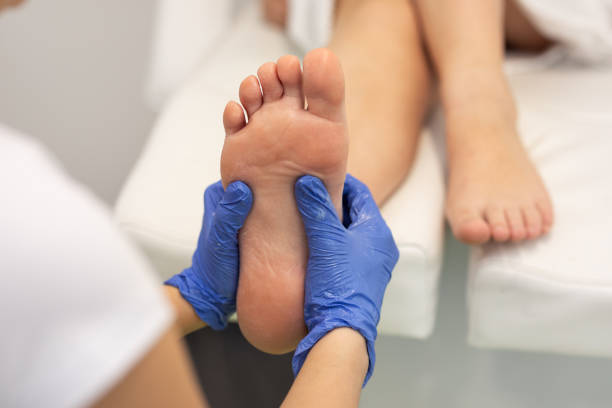
Many people have foot and ankle problems. These problems are not normal and should be examined by a podiatrist.
A podiatrist is a doctor that specializes in the feet and ankles. They can help with many issues such as:
Wearing the Right Footwear
The feet are a very important part of the body. They work in tandem with every muscle and joint to provide a foundation for all the activities of daily life. If they are not properly supported, then problems can arise that affect the knees, ankles, back and hips. The right footwear can help reduce these problems and improve posture.
A podiatrist can advise you on the best shoes for your feet. They will consider the shape of your foot and the types of activities that you do as well as your personal style. They will recommend shoes that are comfortable, breathable and have good arch support. They will also take into account your medical history and medications that you may be taking.
They can advise you on a wide range of styles and brands of shoes that are appropriate for your specific needs. They can advise you on the best shoes for walking, sports, work and leisure activities. They can also assist you in finding a shoe that will be suitable for different foot conditions and health issues, including diabetes and arthritis.
Wearing the wrong type of shoes can cause serious long term damage to the feet and legs. This can result in a variety of conditions, such as corns, bunions and hammertoes. It can also lead to more serious conditions, such as deformities, loss of fatty tissue and even amputations.
Your podiatrist will recommend footwear that can correct problems and prevent them from getting worse. They can also recommend orthotics, which are a biomechanical insert that is custom-fitted to your feet by your podiatrist and helps to support the body in an optimal position when weight bearing.
While it is true that in the past podiatrists have tended to be more conservative in their footwear recommendations, there has been a shift in both the podiatric profession and the industry. There are now a number of fashionable and comfortable shoes available that are both stylish and supportive. These are often designed to accommodate different foot shapes and can be found in a range of price points.
Keeping Your Feet Clean
The human feet are a remarkable feat of biomechanical engineering. Each one has 26 bones, 33 joints (all of which move), and over 100 muscles, tendons and ligaments that are all working together perfectly to keep us moving. But because we take our feet for granted, they are often neglected.
That’s why it’s important to keep up with the basic foot care tips, like washing your feet daily and regularly checking for any changes in color, texture or temperature. You should also wear socks made of breathable fabrics that can help your feet stay dry. Finally, inspecting your toenails for signs of infection and trimming them regularly is vital.
If you notice any of these issues or have other concerns about your feet, it’s a good idea to see a podiatrist. A podiatrist has a unique education and training that makes them an expert in the foot, ankle and lower leg. Look for a doctor with the letters DPM after their name to ensure you’re seeing a true foot and ankle specialist.
Podiatrist Claremont can provide a range of services, including nail and minor-soft-tissue surgical procedures. They can also treat some conditions caused by other medical problems, such as diabetes. For example, some diabetics have a problem called morton’s neuroma, which causes pain and a feeling that there is something stuck between the third and fourth toes. A podiatrist can give shots and recommend orthotics to relieve the condition.
Other conditions that podiatrists may treat include bunions, calluses, and heel pain. Heel pain is commonly associated with running or poorly-fitting shoes. The cause is often a buildup of calcium at the base of the heel, which can lead to inflammation and pain. In some cases, a podiatrist will remove the calcified tissue.
Podiatrists are also often consulted about sports injuries to the foot and ankle, especially running-related injuries. They can recommend stretches, ice packs, and orthotics to prevent or treat injury. They can also prescribe medications to ease pain and swelling, and perform surgery if necessary.
Keeping Your Feet Warm
Your feet do a lot of work for you. They support your weight, allow you to run and walk, and help you stand upright. As such, it’s important to take care of your feet so they can keep you healthy. A podiatrist is a health specialist who specializes in treating foot and ankle conditions. They can treat everything from ingrown toenails to diabetic foot complications. They can also perform surgeries and prescribe orthotics to help treat foot problems.
Many people suffer from cold feet during the winter because of a lack of blood flow to their extremities. This can weaken the immune system and cause various chronic diseases. However, there are some things you can do to warm your feet up and boost the immune system in the process. Some of these include wearing thick and insulated winter footwear, keeping the body warm by covering it with appropriate clothing, and eating foods that increase circulation.
A foot specialist can help you prevent or treat a wide range of foot and ankle problems including bunions, ingrown toenails, calluses, heel pain, sports injuries, and diabetic foot complications. They can also prescribe orthotics, shoes or in-shoe padding to help alleviate your symptoms. They can even use cryotherapy to freeze off plantar warts.
If you are suffering from a condition that causes cold feet, it’s important to seek medical attention as soon as possible. The sooner you see a podiatrist, the better the chances of preventing further damage and improving your condition.
After completing four years of undergraduate study, podiatrists spend another four to seven years in medical school learning how to treat their patients’ feet and ankles. After graduating, they can then spend up to three years in a hospital performing a residency. This is where they learn how to practice as a physician and deal with real-life patient situations. After their residency, they can choose to specialize in a specific area of podiatry such as treating diabetes or treating children’s foot issues. They can also get additional certifications to expand their skills. In addition, podiatrists can also join a fellowship to further improve their skills and knowledge in a specific field of podiatry.
Keeping Your Feet Dry
Keeping your feet dry is essential to the prevention of a variety of foot problems including fungi, bacteria and cracked skin. Dry feet are less prone to irritation and are also less prone to developing painful neuromas (a condition that causes burning, tingling and sharp pain in the toes).
To keep your feet from drying out, make sure you wash them regularly with mild soap and then thoroughly dry them. Do not walk around with wet feet because it will encourage the growth of microorganisms that can cause infections and odors. It is best to wear shoes that fit well and to avoid socks made of cotton because they hold moisture next to your skin, which can lead to a variety of problems.
Some health conditions that can affect the feet include diabetes and rheumatoid arthritis. If you have any of these conditions, it is important to see a podiatrist often because foot problems can get worse over time if they are not treated properly.
A podiatrist is a medical professional who specializes in the diagnosis and treatment of diseases, injuries and disorders of the feet and lower legs. They are also experts in the prevention of foot problems. They are trained to perform surgery on the feet and ankles and can also prescribe medications, perform lab tests and order X-rays.
Although podiatrists are doctors, they do not attend traditional medical school. They have their own schools and professional associations, and they have the title Doctor of Podiatric Medicine or DPM. In the United States, podiatrists can reset broken bones and perform surgeries on their patients’ feet.
When you go to the podiatrist, they will start by taking a complete history of your foot and leg problems. They will ask you to walk, move your toes in different directions and to stand on one foot. They may also take an X-ray or do other imaging tests such as ultrasound, CT scan or an MRI.
A podiatrist can help you with a wide range of foot problems, from sports injuries to deformities caused by aging or by diseases such as diabetes. They can also help with foot problems related to other medical conditions such as heart disease and obesity.







